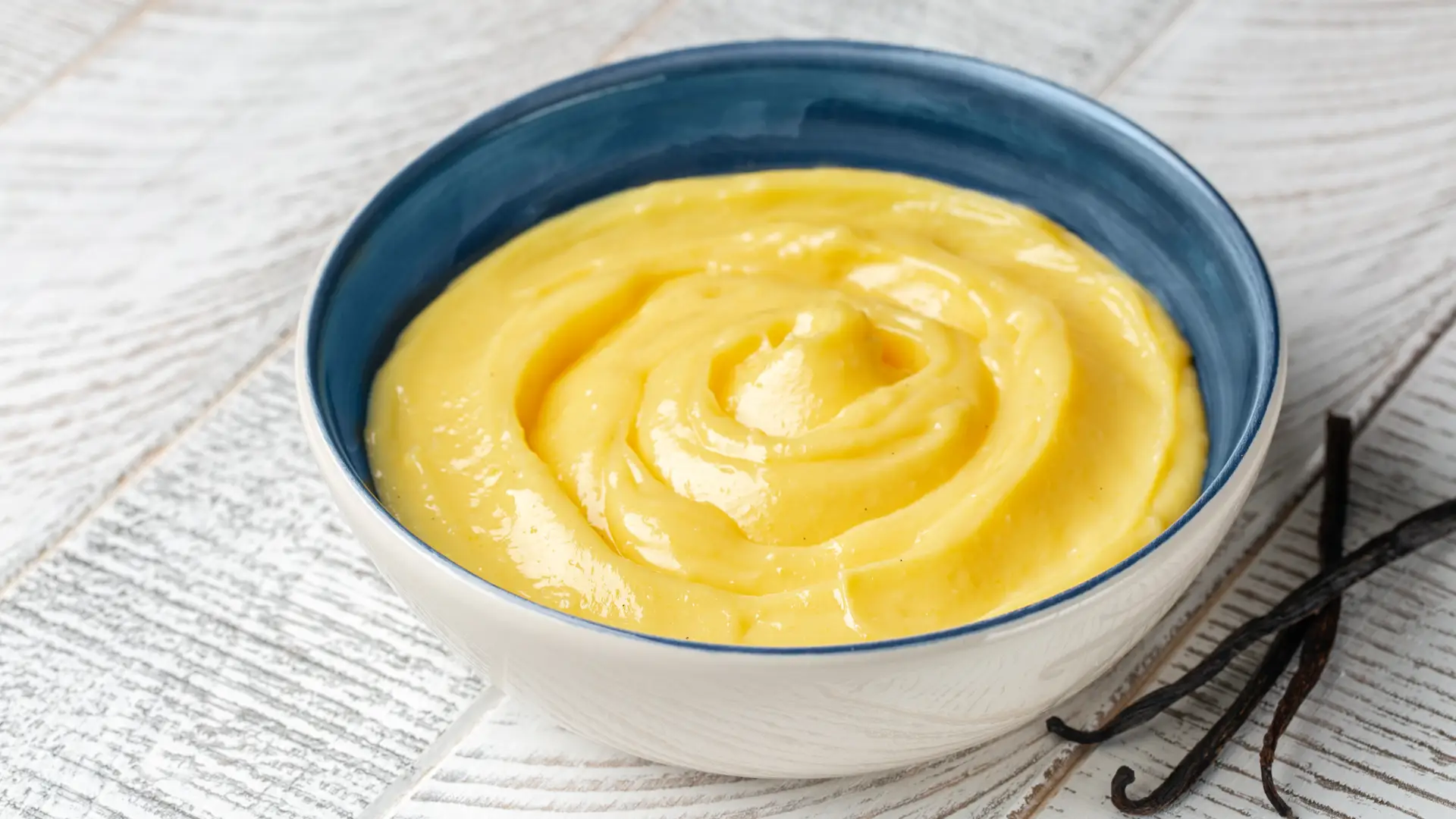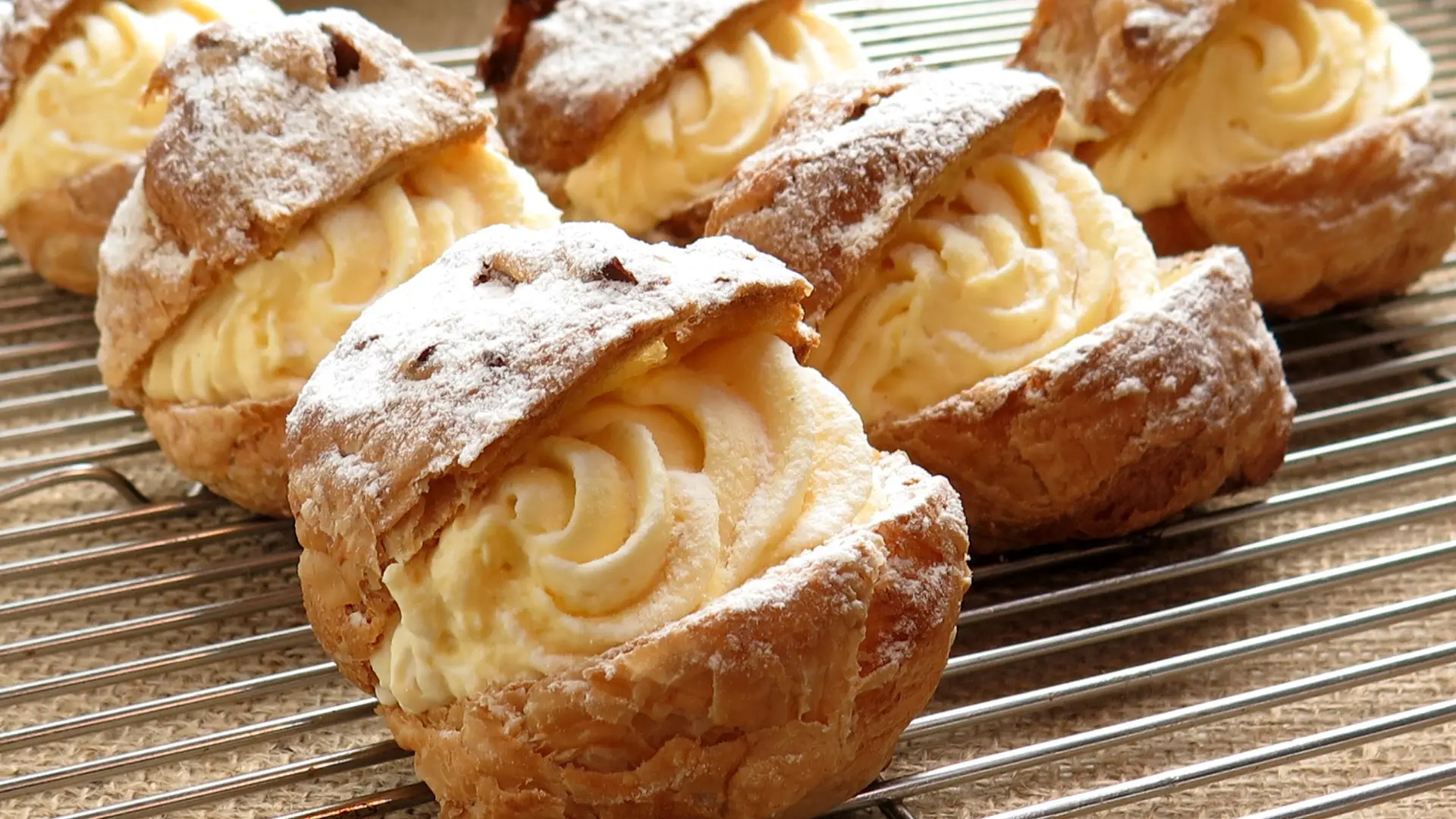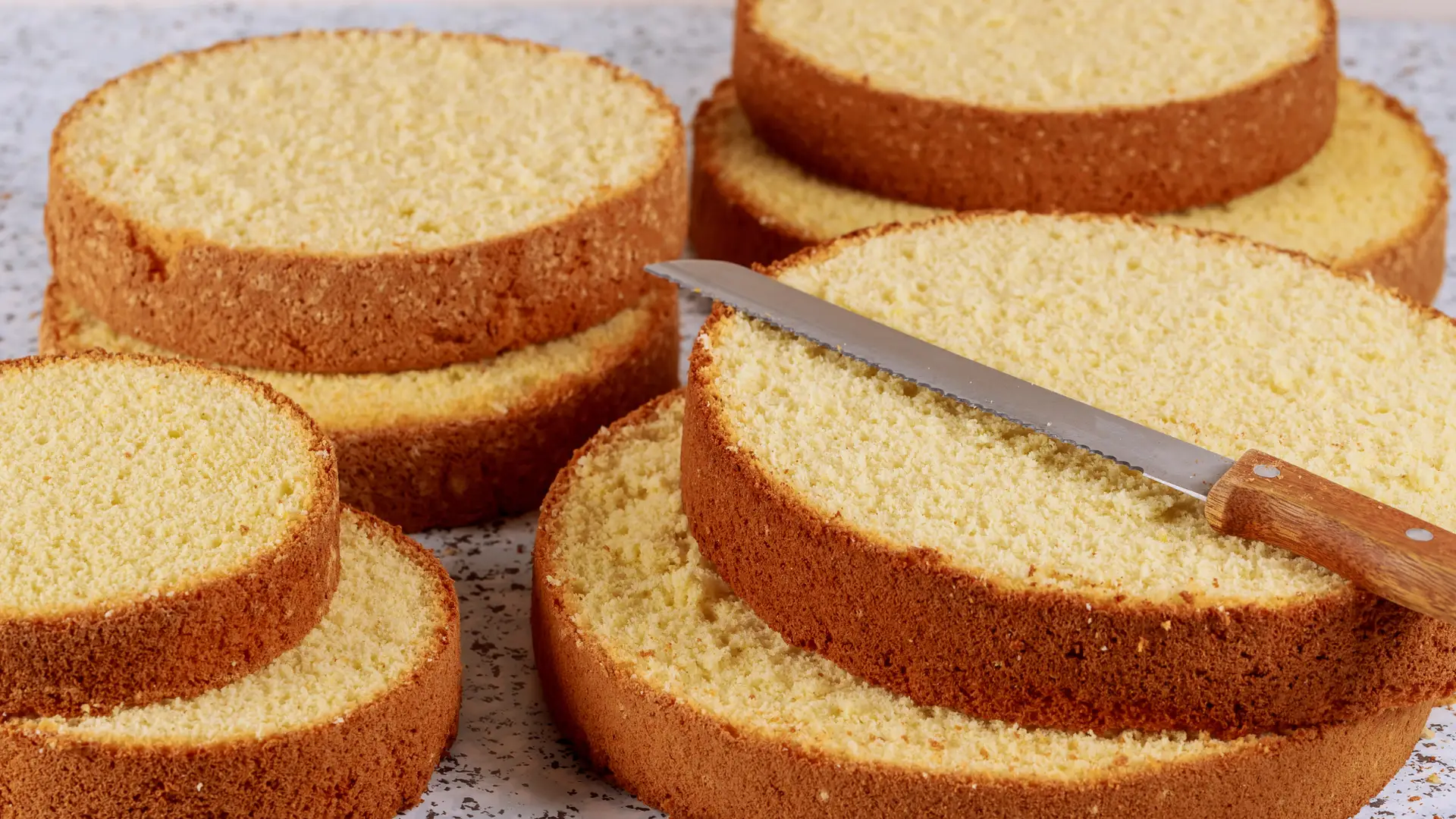
When it comes to Christmas, Panettone is a must! The recipe I am proposing is based on that of master Rolando Morandin, entirely prepared with Sourdough. Preparing Panettone at home is undoubtedly tricky, let's be honest! In fact, the recipe is quite long, and there are many aspects to know to read the signs (positive or negative) of the dough... But do not get discouraged, and most of all, do not get frustrated if the first attempt does not meet your expectations! If you carefully follow my advice, I guarantee you will succeed.If you want to discover more tricks, have a look at How to Make Panettone.
Prep Time: 1 ora ora
Cook Time: 1 ora ora
Rising Time: 21 ore ore
Total Time: 23 ore ore
4 Panettones of 1kg
Equipment
- Stand Mixer
- Metal Skewers
- Cooking Thermometer
- Feed Grade Bags
- Immersion Blender
Ingredients
For the First Dough
- 800 gr Panettone Flour (00) ((W360, 14% - 15% of proteins))
- 500 gr Softened Butter
- 450 gr Sourdough starter (Fed 2 or 3 times)
- 350 gr Granulated Sugar
- 250 gr Egg Yolks ((Quantity 1))
- 200 gr Water ( at 30°C (86°F) (Quantity 1))
- 200 gr Egg Yolks ((Quantity 2))
- 100 gr Water ( at 30°C (86°F) (Quantity 2))
For the Second Dough
- 400 gr Panettone Flour (00) ((W360, 14% - 15% of proteins))
- 135 gr Egg Yolks
- 100 gr Softened Butter ((170gr if you won't use Clarified Butter))
- 70 gr Granulated Sugar
- 60 gr Clarified Butter (Ghee)
- 50 gr Honey
- 50 gr Candied Orange Peels in Paste
- 50 gr Flavoring Paste for Leavened Doughs (if you won't use Candied Orange Paste - Click here )
- 2 pods Vanilla Bourbon
- 24 gr Salt
Filling
- 500 gr Sultana Raisins (washed and re-hydrated)
- 300 gr Candied Orange Peel ((diced))
- 50 gr Candied Citron Peel ((diced))
Instructions
For the First Dough
- First of all, prepare a syrup by dissolving sugar and egg yolks in the water at 30°C (86°F), using an immersion blender.
- Pour the syrup into the mixer bowl and add the sourdough after the second or third refreshment.
- Knead for about 2minutes, so you can dissolve the Sourdough before adding the flour.
- Add the flour and let the dough form a glutinous mesh which must be elastic and extensible. This step is crucial for the success of the Panettone recipe.
- Check the proper formation of the glutinous mesh, taking a piece of dough and spreading it with your hands until it forms a thin layer of dough.
- Once the dough is amalgamated and elastic, add the second dose of egg yolks, allowing them to be correctly absorbed. Finally, add the water (quantity 2) according to the recipe.
- When the dough is fully developed, add the soft butter at room temperature in several batches, allowing it to be thoroughly absorbed into the dough.
- The first dough is ready. Transfer it into a large container, sprinkle the surface with some small pieces of soft butter, and let it rise at 22-24°C (71°F - 75°F) for 15h until it has tripled its volume. Fermentation time depends on room temperature; therefore, before proceeding with the next dough, make sure the dough has tripled its initial volume. To better visualize the development of the dough, I suggest creating a "graduated scale" on the container, marking the starting volume and the desired volume at the end of fermentation.
For the Second Dough
- Pour the first dough now-fermented into the bowl of the stand mixer.
- Knead the first dough together with the flour very well until forming a strong and elastic gluten mesh
- Add the egg yolks and knead until they are completely absorbed.
- Then add the sugar, honey, and candied orange paste (or the aromatic mix you have prepared) and allow to knead until the dough detaches from the mixer bowl.
- Mix without whipping the butter, clarified liquid butter, salt, and vanilla. Then add the mixture to the dough, a little at a time, allowing it to be well absorbed between each addition.
- Once the dough is well combined, add the raisins and candied fruit and turn the mixer for about 1-2min on low speed.
- Let the dough rise for about 1 hour to relax the gluten and complete the hydration of the proteins.
- For 1kg Panettone, divide 1100gr portions of dough and let rest on the table for 5minutes.
- Roll up the dough to stretch the gluten and form tight loaves. Place in paper molds (1kg) and let them proof at 26-28°C (79°F - 82°F) for 5-6 hours.
- The real Milanese Panettone is finished with the "scarpatura".For this, you score a cross on the Panettone surface, lifting the 4 edges. You place a cube of soft butter in the center and finally close the edges towards the center. This particular operation favors the growth of the panettone. It creates a larger toasted surface during baking with the consequent development of a more complex and pleasing aromatic system.
- Bake in a static oven at 150°C (302°F) for about 45-50min.
- To test cooking, check that the temperature at the heart of the product is between 92°C and 94°C (197°F - 205°F).
- Remove the panettone from the oven, pierce them with the appropriate metal skewers and turn them upside down for at least 2-3 hours.
- Let the Panettone cool completely before packing it in food-grade bags. I also recommend waiting a couple of days before tasting your Panettone to allow the aroma to spread into the cake.
Notes
The raisins must be prepared the night before the dough.
Rinse it twice in hot water at 50°C (122°F) with a little food-grade alcohol to properly clean it from the preservation waxes.
Then soak it in lukewarm water (35°C - 95°F) for 1 hour, without using alcohol or spirits (which might interfere with the fermentation). Finally, let it fully drain and lay it on a perforated pan, or spread it onto a clean cloth. Clarified Butter is liquid butter at room temperature, which gives an extraordinary softness to the Panettone. It's also great for the preparation of Choux and Shortcrust pastries. The Panettone's aroma is entirely developed in 2-3 days after baking; therefore, wait a few days before tasting it. Candied Orange Paste is an exceptional solution to flavor your Panettone in a natural way.
Rinse it twice in hot water at 50°C (122°F) with a little food-grade alcohol to properly clean it from the preservation waxes.
Then soak it in lukewarm water (35°C - 95°F) for 1 hour, without using alcohol or spirits (which might interfere with the fermentation). Finally, let it fully drain and lay it on a perforated pan, or spread it onto a clean cloth. Clarified Butter is liquid butter at room temperature, which gives an extraordinary softness to the Panettone. It's also great for the preparation of Choux and Shortcrust pastries. The Panettone's aroma is entirely developed in 2-3 days after baking; therefore, wait a few days before tasting it. Candied Orange Paste is an exceptional solution to flavor your Panettone in a natural way.
Nutrition
Serving: 100g | Calories: 4245kcal | Carbohydrates: 648g | Protein: 65g | Fat: 162g | Fiber: 24g | Sugar: 235g


























74 comments about “Panettone con Lievito Madre”
buongiorno chef,
con la sua ricetta sto facendo parecchi panettoni ma il secondo impasto ha dei problemi
il primo ha una perfetta maglia glutinica e sta in lievita dalle 21 alle 7 del giorno dopo triplicando
esce dal forno lievita a 27 gradi, lo faccio riposare a temp amb perché raffreddi un po
lo metto in macchina ( spirale ) e molto lentamente aggiungo la farina
la forma in macchina è a testa aglio ma l’impasto è a 25 gradi , assorbe bene la farina ma non è liscio, sembra che si stia dividendo, non è lucido.
aggiungo i tuorli e sempre in prima velocità li assorbe bene perde ancora 2 gradi ma rimpasto non è liscio
il mio lievito per il pane è perfetto, non è acido, prima dei panettoni gli faccio il bagnetto e lo rinfresco 3 volte
Ciao Marco,
questo ti capita perché l’impasto non prende nervo.
Quando tiri fuori l’impasto dal ferma lievita, fallo raffreddare a 18-20°C se usi la spirale. Usa tuorlo freddo a +4°C.
Quando metti la farina, mettila tutta insieme, farla assorbire e quando l’impasto si sarà formato, fagli prendere nervo in seconda velocità.
Stessa cosa quando metti i tuorli e gli zuccheri.
Se hai difficoltà a formare l’impasto, perché diventa appiccicoso, allora il primo impasto ha acidificato troppo. Se hai il phmetro, controlla che sia a 5.3. Nel caso abbassa la temperatura della cella a 26°C!
A presto!
Salve, ho provato la ricetta del panettone e avrai de le domande…
Primo, la lievitazione del secondo impasto e durata 20ore circa (10ore a temperatura ambiente, 10ore nel forno con la luce, 28C)! Questo dopo la lievitazione del primo impasto di 16h a 28C, era un po’ più del doppio quando ho cominciato il secondo impasto. (L’unica cosa che ho cambiato e che non trovo la farina per panettone in America e quindi ho fatto una micella con la farina di contenuto proteico al 70-80%)
Ne voleri fare tanti per Natale da regalare, ma 9 tuorli per uno sono proprio tanti! E possibile fare il panettone con l’uovo intero (mantenendo il peso di uova richiesto ma usando pure il bianco)? O pure rimpiazzando una parte del peso di tuorli con l’acqua, latte, etc.
Scusate se sono un po’ sgrammaticata, non sono abituata a scrivere in Italiano….
Grazie!
Ciao Delia!
il tuo lievito è troppo debole, oppure un pò troppo acido. Questo determina il fatto che l’impasto fa fatica a lievitare (sopratutto se riesci a garantire una temperatura costante).
Devi identificare il problema, nei giorni precedenti ai rinfreschi per fare il Panettone. Ti linko un articolo che potrebbe esserti utile: https://biancolievito.it/s-o-s-lievito/
Per quanto riguarda le uova, tecnicamente è possibile, ma aggiungerai molte proteine insieme all’albume e avrai un prodotto meno soffice.
Inoltre dovrai bilanciare un pò la ricetta. Provo a spiegartelo, ma non è facilissimo. Ti consiglio di togliere solo dal PRIMO IMPASTO
Ogni 100gr di tuorlo che togli devi:
1) Togliere 30gr di acqua del primo impasto
2) Aggiungere 40 gr di burro
Spero di averti aiutato!
Cheers from Milano!
Salve buonasera mi chiamo besi e scrivio da Assisi , ho creato il mio primo impasto dell panettone con una planetaria casalinga fin a un certo punto andava bene poi dal meta del inserimento della 2parte di burro e tuorli si e creata una pappa come una crema . Non mi rendo conto dove ho sbagliato, ho usato il mio lievito madre all terso rinfresco all 40%di idr ( 100 g farina 100g lievito 40g acqua) se sareste così gentili da darmi una dritta per il tentativo seguente
Ciao Besi,
in pratica ti è collassato l’impasto. Molto probabilmente hai usato una farina troppo debole, oppure con la planetaria hai scalato troppo l’impasto (non devi mai superare i 28°C)!
A presto!
Ciao buonasera come farina ho usato la petra x panettone e poi anche la temperatura era piu bassa ho lavorato con il gancio e poi ho fatto caso che la seconda parte di burro laa preso subito
Allora potrebbe essere che il primo impasto era un pò acido, oppure non hai fatto incordare bene il secondo impasto con la farina!
A presto!